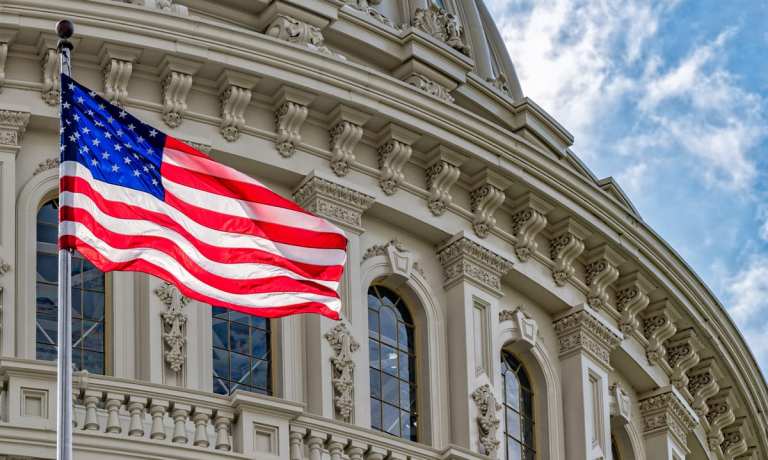
The U.S. Congress is looking to bring stablecoins deeper into the regulatory fold.
And potentially the broader global financial system.
A new 73-page draft bill, published Saturday (April 15) by the U.S. House Financial Services Committee is proposing that the Federal Reserve’s board of governors be given oversight of nonbank entities and digital asset firms looking to issue stablecoins.
The discussion draft, titled “A bill to provide requirements for payment stablecoin issuers, research on a digital dollar, and for other purposes,” lays out a series of stricter rules around the issuance of dollar-pegged digital assets across both the federal and state level, as well as establishes requirements for interoperability, reporting and enforcement.
It represents the first major piece of crypto legislation that lawmakers have so far shared in 2023.
The draft also proposes a two-year moratorium on the creation and issuance of algorithmic stablecoins as well as those backed by other cryptocurrencies, and it separately includes a request by the U.S. Treasury to study the feasibility and working impact of a digital dollar central bank digital currency (CBDC).
Penalties for firms and platforms that issue stablecoins without regulatory approval include prison time of up to five years, as well as a $1 million fine.
Read also: Will FedNow’s July Launch Make Crypto and Stablecoins Redundant?
Jeremy Allaire, CEO of crypto company Circle, which issues the USD Coin (USDC) stablecoin tweeted Saturday that the bill represents “an extraordinary moment for the future of the dollar in the world, and the future of currency on the internet.”
2/ It’s an extraordinary moment for the future of the dollar in the world, and the future of currency on the internet. There is clearly the need for deep, bi-partisan support for laws that ensure that digital dollars on the internet are safely issued, backed and operated.
— Jeremy Allaire (@jerallaire) April 15, 2023
Circle’s USDC stablecoin is the second-largest dollar-pegged token by both market capitalization and circulating supply, behind Tether’s USDT stablecoin and ahead of Binance USD’s BUSD coin.
Both USDT and BUSD have separately come under scrutiny in recent months, and USDC was temporarily de-pegged from its $1 backing following the collapse of Silicon Valley Bank (SVB), where Circle kept $3.3 billion of its assets.
“There is clearly the need for deep, bi-partisan support for laws that ensure that digital dollars on the internet are safely issued, backed and operated,” Allaire tweeted, adding that “there are clearly open and challenging issues with the bill as proposed.”
“It’s time for U.S. leadership, and that means clear regulation and empowering entrepreneurship and innovation within the framework of U.S. prudential law… now is the time for our country and political leaders to really dig in and get this right,” he added. “The role of the dollar in the world is at stake.”
See also: Regulators Clear Stablecoin Path for Reluctant Banks
As part of the bill’s proposed requirements, stablecoin issuers must “publish the monthly composition of the issuer’s reserve portfolio on the website of the issuer, in a format established, jointly, by the federal payment stablecoin regulators.”
Acceptable backing apparatus for the coins includes U.S. currency, central bank reserve deposits, Treasury bills with a maturity of 90 days or less, as well as certain repurchase agreements backed by Treasury bills with the same maturity period. This is essentially a codification of the model that stablecoins including USDC, USDT and BUSD already follow.
The legislation also requires that redemption requests, which are when stablecoin holders trade in their tokens for the national currency backing it, must be executed in a timeframe no “longer than one day after the redemption request.”
The published draft of the stablecoin bill comes in advance of a scheduled Wednesday (April 19) hearing during which the House subcommittee on digital assets, financial technology and inclusion will meet to discuss cryptocurrency in a session titled, “Understanding Stablecoins’ Role in Payments and the Need for Legislation.”
In an interview with PYMNTS’ Karen Webster last year, Rep. Patrick McHenry — who now heads the committee — said he wanted to focus on stablecoins if Republicans retook the House.
Among others, the witness list will include New York State Department of Financial Services (NYSDFS) Superintendent Adrienne Harris; Circle’s head of global policy, Dante Disparte; and the Blockchain Association’s chief policy officer, Jack Chervinsky.
This Wednesday’s (April 19) discussion will follow another House Financial Services Committee hearing Tuesday (April 18) with Securities and Exchange Commission (SEC) Chair Gary Gensler set to cover the agency’s regulatory developments and rulemaking, with a particular focus on crypto.
For all PYMNTS crypto coverage, subscribe to the daily Crypto Newsletter.